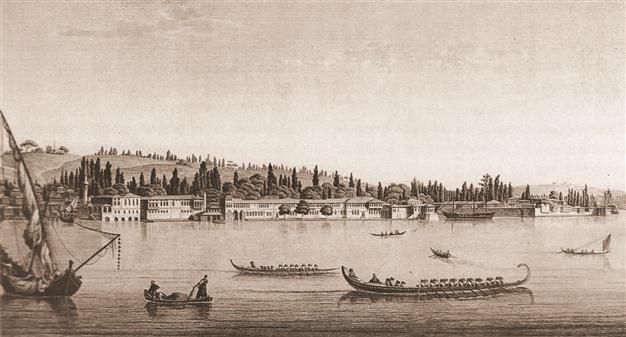The Golden Horn: A harbor for all seasons
ISTANBUL - Hürriyet Daily News

The Golden Horn was one of the great boat basins for pleasure cruising at the time of the Ottoman. Members of the imperial dynasty built palaces in Eyüp district as well as mosques and schools but the palaces are now gone. DAILY NEWS photo, Emrah GÜREL
Row, row, row your boat / gently down the Horn.Once upon a time the Golden Horn was one of the great boat basins for pleasure cruising (when boats mostly used oar power) and transportation from Kasımpaşa to Balat and Karaköy to Eminönü and may be again in the future.
That was before ships dumped bilge and oil into the water, industry on shore thought it was all right to release chemicals therein and people could conveniently get rid of their waste water.
This waterway that cuts through the oldest and newer parts of Istanbul is the confluence of streams draining from the hills on the northern side of the city. Over the centuries, the water cut a deep channel (35 meters) as it flowed down to meet the Bosphorus Strait and the Sea of Marmara.
It made an excellent, wind-protected harbor for boats that hugged the coastline and later for those ships equipped to sail out of sight of land. The first settlers seem to have been fishermen and hunters, followed by farmers, dairy herders and traders.

The depth of the water allowed trading ships in medieval times to tie up quite close to the shore so warehouses and shops of various sorts sprang up and wholesale fish and fruit and vegetable markets developed at the Eminönü neighborhood, of Fatih district. No one knows to this day whether the Mısır Çarşı is the Egyptian Bazaar or the Corn Bazaar, but it was on the wharves there that corn (mısır) was unloaded from ships coming from Egypt (Mısır).
What had started under the East Romans (later Byzantines) continued more or less the same under the Ottomans except the population grew and the city expanded. Members of the imperial dynasty built palaces in Eyüp district as well as mosques and medreses (schools), traveling there by boat. The palaces are now gone and it’s a pity they can’t tell us their tales.
For instance the chronicler, Mehmed Raşid Efendi, writes that the debate over attacking Venice in the Morea in 1714 occurred in the Eyüp home of Sultan Ahmed III’s mother who was Greek, not in the Council of State’s formal meeting room at Topkapı Palace.
Eyüp hallowed area
The Ottomans also considered Eyüp a particularly hallowed area in which to be buried since the main mosque contained the body of one of the Prophet Mohammed’s companions, turning the place into one of the three holy places of pilgrimage in Islam. Many quite interesting headstones and mausoleums give visitors today the impression that the place is a city of the dead.
The undeveloped land on the northern side of the Golden Horn between Eyüp and the Kasımpaşa quarter of Beyoğlu district must have been very tempting, because some sultans began to erect small palaces on the Galata side around Kasımpaşa, where there were a few tiny settlements and a cemetery.
At the beginning of the 17th century, Sultan Ahmed I had a small kiosk with private quarters for his harem built here along the shore, and travel writer Evliya Çelebi talks of how he and friends would go break their fast in this area during the nights of Ramadan.
The whole area around Kağıthane district was transformed at the beginning of the 18th century when Sultan Ahmed III with his grand vizier turned this northern part of the Golden Horn into a pleasure park. The sultan had a small palace built and surrounded it with kiosks, pools, fountains, hamams and gardens laid out in western fashion during what has been termed the Lale Devri (Tulip Period). Here the streams that drained into the Halic were called the “Sweet Waters of Europe.”
Following the end of the Tulip Period, this became an area for the wealthy and the well-connected to see, be seen and to go pleasure boating, until the water became too polluted.
The northeastern portion of the Horn around Kasımpaşa was where Fatih Sultan Mehmed II had shipyards built shortly after his conquest of the city. They were transformed during the 19th century to handle modern ships and contribute their share of the polluting. They still stand.
The merchants and warships are gone today, and undoubtedly Sultan Ahmed III and his grand vizier would be happy to see that the Golden Horn is once again being turned into a place for meetings and pleasure.
















